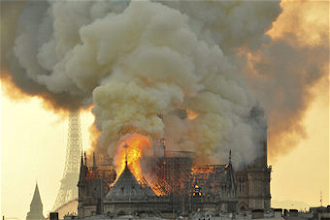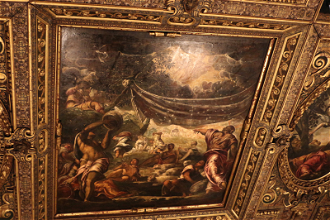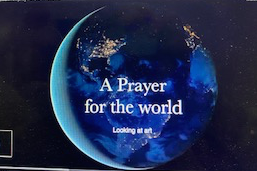Today's Gospel in Art - The Passion of our Lord Jesus Christ

Scenes from the Passion of Christ, by Hans Memling, 1470 - 1471, © Sabauda Gallery, Turin
Gospel of 10th April 2020 - John 18:1-19:42
Key: N Narrator. *Jesus. O Other single speaker. C Crowd, or more than one speaker.
N. Jesus left with his disciples and crossed the Kedron valley. There was a garden there, and he went into it with his disciples. Judas the traitor knew the place well, since Jesus had often met his disciples there, and he brought the cohort to this place together with a detachment of guards sent by the chief priests and the Pharisees, all with lanterns and torches and weapons. Knowing everything that was going to happen to him, Jesus then came forward and said,
* Who are you looking for?
N. They answered,
C. Jesus the Nazarene.
N. He said,
* I am he.
N. Now Judas the traitor was standing among them. When Jesus said, 'I am he', they moved back and fell to the ground. He asked them a second time,
* Who are you looking for?
N. They said,
C. Jesus the Nazarene.
N. Jesus replied,
* I have told you that I am he. If I am the one you are looking for, let these others go.
N. This was to fulfil the words he had spoken, 'Not one of those you gave me have I lost.'
Simon Peter, who carried a sword, drew it and wounded the high priest's servant, cutting off his right ear. The servant's name was Malchus. Jesus said to Peter,
* Put your sword back in its scabbard; am I not to drink the cup that the Father has given me?
N. The cohort and its captain and the Jewish guards seized Jesus and bound him. They took him first to Annas, because Annas was the father-in-law of Caiaphas, who was high priest that year. It was Caiaphas who had suggested to the Jews, 'It is better for one man to die for the people.'
Simon Peter, with another disciple, followed Jesus. This disciple, who was known to the high priest, went with Jesus into the high priest's palace, but Peter stayed outside the door. So the other disciple, the one known to the high priest, went out, spoke to the woman who was keeping the door and brought Peter in. The maid on duty at the door said to Peter,
O. Aren't you another of that man's disciples?
N. He answered,
O. I am not.
N. Now it was cold, and the servants and guards had lit a charcoal fire and were standing there warming themselves; so Peter stood there too, warming himself with the others.
The high priest questioned Jesus about his disciples and his teaching. Jesus answered,
* I have spoken openly for all the world to hear; I have always taught in the synagogue and in the Temple where all the Jews meet together: I have said nothing in secret. But why ask me? Ask my hearers what I taught: they know what I said.
N. At these words, one of the guards standing by gave Jesus a slap in the face, saying,
O. Is that the way to answer the high priest?
N. Jesus replied,
* If there is something wrong in what I said, point it out; but if there is no offence in it, why do you strike me?
N. Then Annas sent him, still bound, to Caiaphas the high priest.
As Simon Peter stood there warming himself, someone said to him,
O. Aren't you another of his disciples?
N. He denied it, saying,
O. I am not.
N. One of the high priest's servants, a relation of the man whose ear Peter had cut off, said,
O. Didn't I see you in the garden with him?
N. Again Peter denied it; and at once a cock crew.
They then led Jesus from the house of Caiaphas to the Praetorium. It was now morning. They did not go into the Praetorium themselves or they would be defiled and unable to eat the passover. So Pilate came outside to them and said,
O. What charge do you bring against this man?
N. They replied,
C. If he were not a criminal, we should not be handing him over to you.
N. Pilate said,
O. Take him yourselves, and try him by your own Law.
N. The Jews answered,
C. We are not allowed to put a man to death.
N. This was to fulfil the words Jesus had spoken indicating the way he was going to die.
So Pilate went back into the Praetorium and called Jesus to him, and asked,
O. Are you the king of the Jews?
N. Jesus replied,
* Do you ask this of your own accord, or have others spoken to you about me?
N. Pilate answered,
O. Am I a Jew? It is your own people and the chief priests who have handed you over to me: what have you done?
N. Jesus replied,
* Mine is not a kingdom of this world; if my kingdom were of this world, my men would have fought to prevent my being surrendered to the Jews. But my kingdom is not of this kind.
N. Pilate said,
O. So you are a king, then?
N. Jesus answered,
* It is you who say it. Yes, I am a king. I was born for this, I came into the world for this: to bear witness to the truth; and all who are on the side of truth listen to my voice.
N. Pilate said,
O. Truth? What is that?
N. and with that he went out again to the Jews and said,
O. I find no case against him. But according to a custom of yours I should release one prisoner at the Passover; would you like me, then, to release the king of the Jews?
N. At this they shouted:
C. Not this man, but Barabbas.
N. Barabbas was a brigand.
Pilate then had Jesus taken away and scourged; and after this, the soldiers twisted some thorns into a crown and put it on his head, and dressed him in a purple robe. They kept coming up to him and saying,
C. Hail, king of the Jews!
N. and they slapped him in the face.
Pilate came outside again and said to them,
O. Look, I am going to bring him out to you to let you see that I find no case.
N. Jesus then came out wearing the crown of thorns and the purple robe. Pilate said,
O. Here is the man.
N. When they saw him the chief priests and the guards shouted,
C. Crucify him! Crucify him!
N. Pilate said,
O. Take him yourselves and crucify him: I can find no case against him.
N. The Jews replied,
C. We have a Law, and according to that Law he ought to die, because he has claimed to be the Son of God.
N. When Pilate heard them say this his fears increased. Re-entering the Praetorium, he said to Jesus
O. Where do you come from?
N. But Jesus made no answer. Pilate then said to him,
O. Are you refusing to speak to me? Surely you know I have power to release you and I have power to crucify you?
N. Jesus replied,
* You would have no power over me if it had not been given you from above; that is why the one who handed me over to you has the greater guilt.
N. From that moment Pilate was anxious to set him free, but the Jews shouted,
C. If you set him free you are no friend of Caesar's; anyone who makes himself king is defying Caesar.
N. Hearing these words, Pilate had Jesus brought out, and seated himself on the chair of judgement at a place called the Pavement, in Hebrew Gabbatha. It was Passover Preparation Day, about the sixth hour. Pilate said to the Jews,
O. Here is your king.
N. They said,
C. Take him away, take him away! Crucify him!
N. Pilate said,
O. Do you want me to crucify your king?
N. The chief priests answered,
C. We have no king except Caesar.
N. So in the end Pilate handed him over to them to be crucified.
They then took charge of Jesus, and carrying his own cross he went out of the city to the place of the skull or, as it was called in Hebrew, Golgotha, where they crucified him with two others, one on either side with Jesus in the middle. Pilate wrote out a notice and had it fixed to the cross; it ran: 'Jesus the Nazarene, King of the Jews.' This notice was read by many of the Jews, because the place where Jesus was crucified was not far from the city, and the writing was in Hebrew, Latin and Greek. So the Jewish chief priests said to Pilate,
C. You should not write 'King of the Jews,' but 'This man said: "I am King of the Jews."'
N. Pilate answered,
O. What I have written, I have written.
N. When the soldiers had finished crucifying Jesus they took his clothing and divided it into four shares, one for each soldier. His undergarment was seamless, woven in one piece from neck to hem; so they said to one another,
C. Instead of tearing it, let's throw dice to decide who is to have it.
N. In this way the words of scripture were fulfilled:
They shared out my clothing among them.
They cast lots for my clothes.
This is exactly what the soldiers did.
Near the cross of Jesus stood his mother and his mother's sister, Mary the wife of Clopas, and Mary of Magdala. Seeing his mother and the disciple he loved standing near her, Jesus said to his mother,
* Woman, this is your son.
N. Then to the disciple he said,
* This is your mother.
N. And from that moment the disciple made a place for her in his home.
After this, Jesus knew that everything had now been completed, and to fulfil the scripture perfectly he said:
* I am thirsty.
N. A jar full of vinegar stood there, so putting a sponge soaked in the vinegar on a hyssop stick they held it up to his mouth. After Jesus had taken the vinegar he said,
* It is accomplished;
N. and bowing his head he gave up his spirit.
Here all kneel and pause for a short time.
It was Preparation Day, and to prevent the bodies remaining on the cross during the sabbath - since that sabbath was a day of special solemnity - the Jews asked Pilate to have the legs broken and the bodies taken away. Consequently the soldiers came and broke the legs of the first man who had been crucified with him and then of the other. When they came to Jesus, they found he was already dead, and so instead of breaking his legs one of the soldiers pierced his side with a lance; and immediately there came out blood and water. This is the evidence of one who saw it - trustworthy evidence, and he knows he speaks the truth - and he gives it so that you may believe as well. Because all this happened to fulfil the words of scripture:
Not one bone of his will be broken;
and again, in another place scripture says:
They will look on the one whom they have pierced.
After this, Joseph of Arimathaea, who was a disciple of Jesus - though a secret one because he was afraid of the Jews - asked Pilate to let him remove the body of Jesus. Pilate gave permission, so they came and took it away. Nicodemus came as well - the same one who had first come to Jesus at night-time - and he brought a mixture of myrrh and aloes, weighing about a hundred pounds. They took the body of Jesus and wrapped it with the spices in linen cloths, following the Jewish burial custom. At the place where he had been crucified there was a garden, and in this garden a new tomb in which no one had yet been buried. Since it was the Jewish Day of Preparation and the tomb was near at hand, they laid Jesus there.
Reflection on the work of art
Isn't this a most beautiful painting! Flemish painter, Hans Memling, managed to paint 23 vignettes of the life of Christ into one painting, including all episodes of the Passion of Christ. If you are looking at this painting on email, or on your mobile phone, I suggest you look at this painting on our website where you can enlarge it and enjoy all the magnificent detail (click here). With many of you in self-isolation or at home for the Easter holidays with your children, it might be a nice thing to do to identify all 23 scenes. You should be able to find the following:
Jesus rides into the city on a donkey on Palm Sunday - top left
Jesus driving the money-changers out of the Temple - to the right of the entry of Jesus
Judas betrays Jesus to the High Priests - down and to the left from the temple scene, in a narrow candle-lit archway
The Last Supper - to the left of the betrayal, in a building with a pitched roof
Prayer in the Garden of Gethsemane - below the Last Supper; three apostles lie sleeping while Jesus prays
Arrest of Christ - down and right from the garden
Denial of Peter - above and right from the arrest: Peter shown in a doorway, with cock crowing above
Christ before Pilate - left of centre; Pilate on his throne (Station of the Cross no.1)
Scourging of Christ - the very centre
Second interrogation of Christ by Pilate - right of centre, skipping across two scenes in a narrow building set back
Crowning with Thorns - right of the scourging
Ecce Homo - right from the crowning with thorns
Preparing of the Cross - down and left, below the scourging
Carrying of the Cross and Simon of Cyrene - below and proceeding to the right, a procession leaves from the city gate, Stations 3 and 5
Jesus is nailed on the cross - top, right of centre, Station of the Cross 11
Crucifixion - above, to the left, Station of the Cross 12
Descent from the cross - to the right, Station of the Cross 13
The Entombment - below the descent from the cross, Station of the Cross 14
Christ in Limbo - to the right of the procession, Christ with a crucifix
Resurrection - above limbo, with the guards asleep
Meeting with Mary Magdalene: Noli me Tangere - above the resurrection
The Road to Emmaus - top right
Appearance before the Apostles at the Sea of Galilee - to the left of the meeting with Mary Magdalene
On this Holy Day, may Christ's light guide our paths and may His sacrifice strengthen our souls, especially during these uncertain global times. Have a Holy Good Friday,
Patrick
LINKS
Today's story - https://christianart.today/reading.php?id=386
Christian Art Today - https://christianart.today
and Holy Week through 100 paintings - www.indcatholicnews.com/news/39289


















